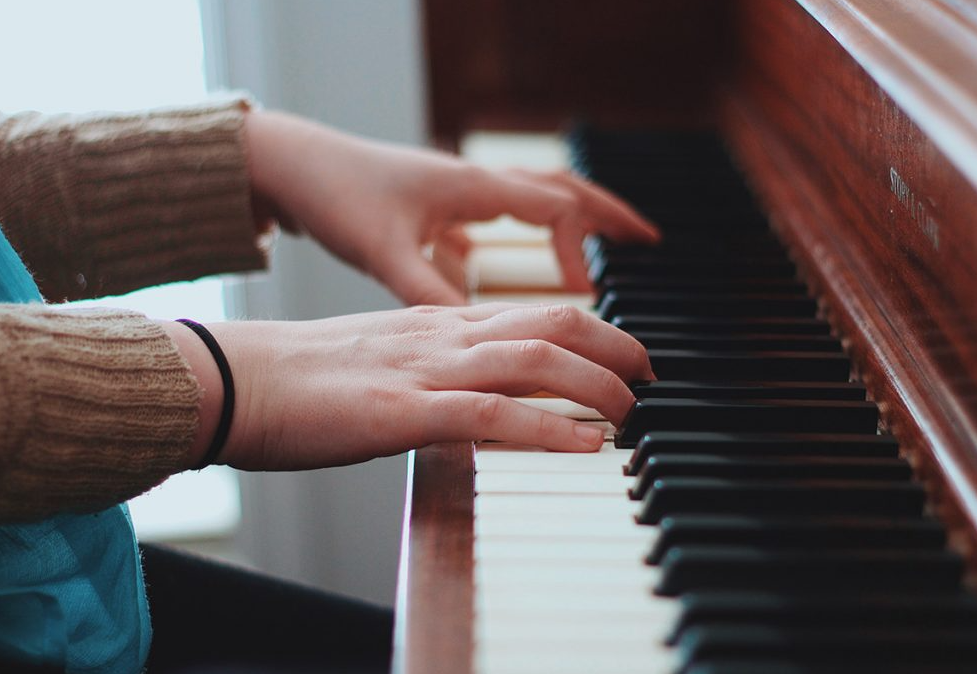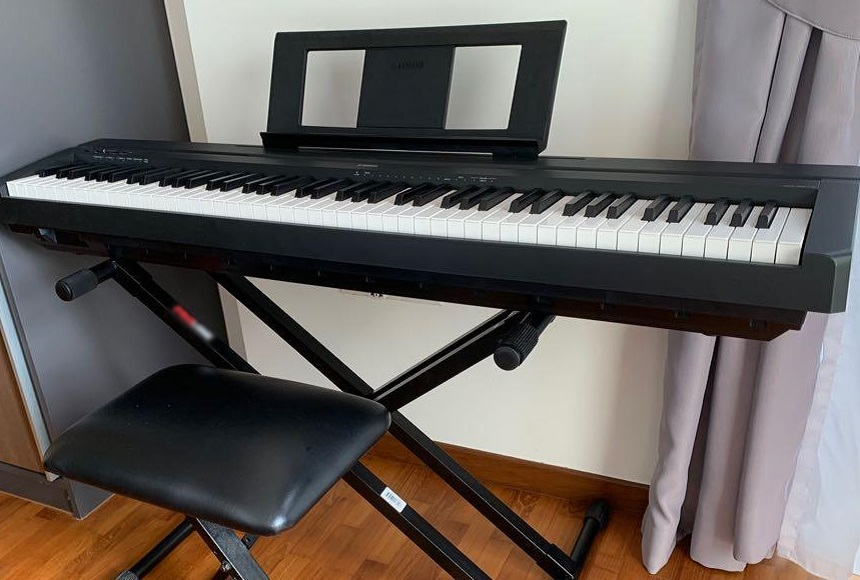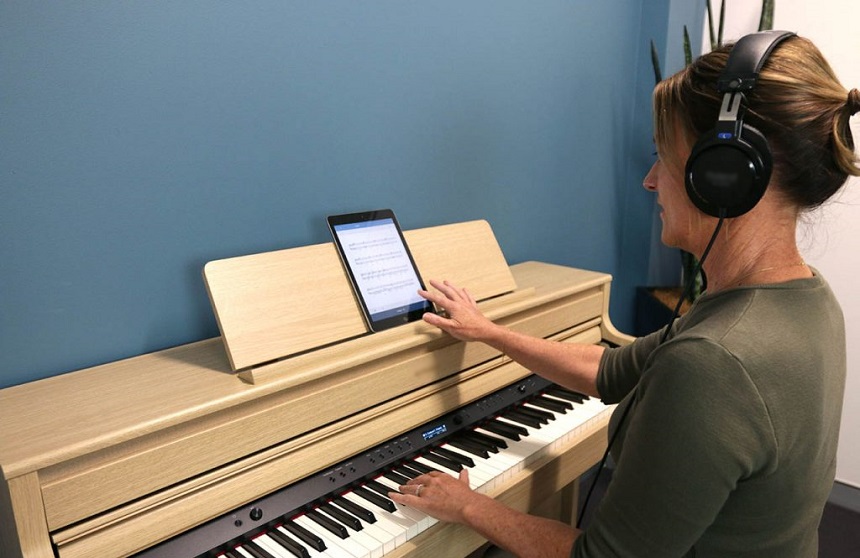
Learning to play piano by yourself is an excellent way to make music and teach yourself independence. Piano classes can be extremely expensive, and you can learn most things you would learn in a class on your own as long as your dedication to the craft. We’ll give you the guidelines you need to learn the piano on your own without the intervention of a teacher. We will walk you through how to choose a piano, learn your notes, and make goals for your learning. The most important thing you need to keep in mind when learning any instrument is it takes practice and patience. If you get on a strict routine, you can learn piano in no time. Even if you took professional piano classes, you would need to set aside time to practice if you want to master your piano.
If you pick out a random piano and don’t take the time to learn about it, you might say yourself up for failure when learning this instrument. If you follow the guidelines below, you can learn how to play the piano with ease and not have to stress about the details. This guide applies to digital keyboards and traditional pianos because these instruments are extremely similar. Our guide will walk you through the basics of playing the piano. The rest of your learning needs to occur during the practice sessions that you set up for yourself. Being diligent about your practice is the most important part of learning this art.

You’ll want to buy a beginner-friendly piano before an expert one because you might not even like the instrument when you start playing. Many people mistake buying the best equipment possible without knowing how to play and then discovering that the piano is not the right instrument for them. A digital keyboard is also an excellent option for beginners because they are cheaper and easier to transport than traditional pianos. The classical piano Trusted Source Classical Music Eras: A History of Classical Music - 2022 - MasterClass Within the broad genre of classical music exists the Classical period. This era of music marked the first time that the symphony, the instrumental concerto (which highlights virtuoso soloists), and the sonata form were brought to wide audiences. www.masterclass.com is massive, expensive, and too heavy for the average person to lug around. A keyboard would also be a good option for beginners because you can take it wherever you go, which means you’ll have more opportunities to practice and hone this art.
However, if you’re dead set on getting a classical piano as a beginner, you should look around for used options. As mentioned before, many people make the mistake of buying a piano and not playing it. Usually, these people will charge much less for a used piano than you would find at a store. Then, you can hire A moving company to transport the piano to your home, so you don’t risk damaging it.
If you purchased your piano from my music store, you can ask the storekeeper if they could tune the piano. Some stores offer this service, and others do not, but many of them do charge extra to do this. Having someone tune your piano Trusted Source Can music improve our health and quality of life? - Harvard Health Humans’ relationship with music is complex and individual, and there are times when music can have a clear and immediate impact on our well-being. Music therapy uses music as a therapeutic tool to address certain health care goals. www.health.harvard.edu before your first play sessions gives you an accurate idea of how it’s supposed to sound while you learn. Then, you can use online resources to learn about the keys on your piano or keyboard and take the time to study these keys. Some pianos even come with a guidebook to help you navigate your first play session and learn the basics. In getting to know your instrument, you can play around with the keys to learn what each sound like without getting too invested in the mechanics.
Another thing you’ll want to learn right off the bat is the hand postures for your piano playing. It would be best to learn hand postures immediately because this is important for habit building, so you don’t have to correct bad habits later. Learning how to do things the right way as soon as possible is the best way to learn your instrument rapidly. Learning things the wrong way and correcting them later can feel counterproductive and frustrating because these bad habits will be ingrained into your hand’s muscle memory while you play. Building the right muscle memory is the first step to a successful learning experience.
The first thing you need to know while you’re playing is that you need to keep your wrists and forearms straight throughout your play session. Correct yourself immediately if you notice these body parts bend at any time, or you’ll slip into bad habits. Then, you’ll want to put your hands in your arms into the C position and maintain this position. When you put your hands into the seed position, they’ll rest in their natural state when you let your hands hang at your sides. To get context on what this should look like, you should rest your arms to your sides and don’t move a muscle. Your hands will form a natural curve, and you can bring them up, maintaining that natural curve, and this will be your C position.
Maintain the C position and keep your arms in position while you practice moving along the keys. At this point, you don’t need to know the notes, yet you need to focus on getting your hands used to the feeling of using these keys in the right position. The more you maintain this position and practice your keys, the better head star you’ll have to learn how to play the piano on your own. When you practice these keys, you should also ensure that you incorporate The Black Keys into your session. Many make the mistake of only practicing the white keys, so they don’t learn how to maneuver efficiently from the white keys to The Black Keys later in their learning sessions. Maintaining your hand position is crucial to avoid injury or straining yourself because playing the piano can be hard on your joints when done incorrectly.
After you acquaint your hands with their keys and get some practice with the proper hand positions, you can start to learn the notes. Learning the right notes for your piano is a fundamental part of playing this instrument because while you’re playing, you can’t always look back at a reference. You should set aside about 30 minutes to study your notes until you have them down. You can easily acquaint yourself with the notes by getting the range of notes down before learning each note on your keyboard. To help yourself with the range of the notes, you should learn the following notes.
After you figure out where all these notes are and practice them, you can expand your knowledge to other notes. These notes are the fundamentals you need to know before you can jump into your piano lessons Trusted Source A Prescription for Music Lessons - PMC Learning to play a musical instrument provides a peaceful retreat from the pressures of daily life. Therapeutic outcomes of playing music include better communication skills, improved emotional release, and decreased anxiety and agitation. Musical training promotes cognitive function, mental health, and a connection to others. www.ncbi.nlm.nih.gov .
After you get acquainted with these notes, finding the other notes on your piano will be much easier while you play. It would be best if you first started with the C and F notes.
After you figure out your notes, it’s time to learn about your sharps end your flat and where to find them on your piano. If you remember above, we had you practice with the black and white keys so that you would get a better feel for playing your instrument. It’s time to bring that practice out because your Black Keys are where your sharps and flats will lie. Your right keys can also play sharps and flats, but your Black Keys will always be sharp or flat and never a primary note. During your learning, you should also remember that sharks are represented with the number symbol and flats are represented with the lowercase b. this knowledge will help you read your music Trusted Source Effects of music learning and piano practice on cognitive function, mood and quality of life in older adults - PMC Reading music and playing a musical instrument is a complex activity that comprises motor and multisensory (auditory, visual, and somatosensory) integration in a unique way. Music has also a well-known impact on the emotional state, while it can be a motivating activity. www.ncbi.nlm.nih.gov better to play the right notes every time.
When you learn how to play the piano, you should set goals for your learning to make progress. Monitoring your progress is the best way to learn an instrument because you can note how much you’ve learned and how long it took to learn that aspect. For example, when you start, you could focus on learning hand positions for the first week and see how you feel about it by the end of the week before making your next goal. When you teach yourself and ask her rent, there’s no specific linear time you need to follow to learn different instrument parts. However, if you don’t set any goals for yourself, you’ll likely feel unmotivated to learn the instrument because you won’t have a deadline to learn the aspects of it. This is why people find themselves with keyboards or pianos that collect dust instead of playing music.
After you become acquainted with how your piano sounds and position your hands, you can set a different practice goal to learn your notes. Set a time to study an aspect of your instrument every day so you can make consistent progress. Even 30 minutes a day will give you significant progress and the steps you need to learn how to master your instrument. The first month of your practice will establish how often you’ll play your piano and help you set good habits. It takes about a month to say I have it, and if you make playing the piano a habit, you’ll learn it quickly. If you neglect to add playing the piano to your daily or weekly routines, you’ll have difficulty learning the basics.

It would help if you practiced mastering the instrument no matter how much you read about learning the piano or listening to music. Keep setting goals for yourself as you learn so you’ll always have steps to move forward and progress your talent.
If you become mentally exhausted from practicing a specific aspect of your piano, you should practice a different aspect. Keeping your practice mixed up will help you stay engaged with your learning. Keep track of your learning, and how you feel during your practice sessions, so you keep practicing.
For example, if your fingers are tired from playing with the keys too much, you could study your notes for a few days to give your fingers a rest. Using your fingers as much as you can when playing the piano might take a while.
After establishing your basics, it’s time to train your fingers to hit the right keys without thinking too hard. When you start to play the music, you won’t have time to figure out where the notes are and locate the right keys. It would help if you took the time to train your fingers so that the notes come naturally to your hands. You can use the pentascale method, which uses five notes and allows you to practice those five before associating yourself with other notes on your keys. After you master the main notes on the scale, you can start doing half notes and quarter notes until you feel comfortable with your piano.
You can also look up a few basic songs with the notes attached and try associating your fingers with the notes on the low-level song.
After you master your notes and train your fingers, you must learn how to time your notes. When you play, know each note has a designated amount of time where you need to hold down the key so that the note rings out fully. If you release the key too quickly, you’ll cut off the note and sound abrupt. A whole note on a music sheet is represented by a white circle, meaning you’ll have to hold down the key for four beats. A white circle with a stem represents the half notes on your music. These half notes are held for two beats. Quarter notes are shaded circles with a stem through which you’ll only hold the key for one beat.
After you master the basics, it would be best to meet other people who play piano so you can compare your learnings. Immersing yourself in piano player culture is a great way to meet like-minded people and improve your skills. You and your new friends can play the piano in front of each other and teach each other helpful tips. Teaching yourself piano can be difficult if you don’t have people to compare your progress and teach you new things. One of the best resources you can have when you teach yourself any instrument is people who are also interested in the same instrument. These people might not be helpful when you’re still figuring out the basics at the beginning of their journey, but they’re extremely helpful when you learn how to play songs.
Practice is the most important thing when it comes to learning any instrument and setting aside 30 minutes today could take you a long way when it comes to learning how to play piano by yourself. Create a routine you can follow weekly and incorporate it into your day to build habits and strengthen your musical skills. If you don’t take the time to practice, then you’ll leave your piano sitting in the dust untouched. If you’ve never played piano before and you’re not sure you like it, you should get a rental or a keyboard before making the big investment for a classical piano. A keyboard would also be good because you can take it anywhere you go, and it takes up less space, giving you more chances to practice.